An unofficial blog about the National Museum of Health and Medicine (nee the Army Medical Museum) in Silver Spring, MD. Visit for news about the museum, new projects, musing on the history of medicine and neat pictures.
Showing posts with label exhibits. Show all posts
Showing posts with label exhibits. Show all posts
Saturday, April 18, 2009
Macauley exhibit opens on Monday
Our exhibit of the original art from David Macauley's latest book on the human body opens on Monday. It was looking good on Friday as about 1/2 the art was hung.
Friday, March 20, 2009
Plastic surgery exhibit in NYC
This rolled in over the e-transom today. I'm not sure yet how I feel about it the idea, but I think it would be an interesting show. - Mike
EXHIBITION OPENING
I am Art - An Expression of the Visual & Artistic Process of Plastic Surgery
Curated by Dr. Anthony Berlet
March 28 - May 9, 2009
Opening reception:
Saturday, March 28, 6-8pm
Presenting work by Anthony Berlet, M.D., Antonino Cassisi, M.D., Michael Cohen, M.D., Scott Spiro, M.D.
Leon Dufourmentel, a pioneer in plastic surgery, said in 1948, “...If I went to Picasso for my portrait, he would probably make me a monster and I should be pleased because it would be worth a million francs. But if Picasso came to me with a facial injury and I made him into a monster, aha, he might not be so pleased.”
This quotation expresses our view, which we hope to share with you in this exhibition, that plastic surgery is a most challenging art form—perhaps the most challenging art form, for our materials are not canvas or clay. Yes, we embrace the great obsession of artists throughout the ages: the human body. But our material is the human body.
We are asked, on a daily basis, to do the impossible, to make the real ideal, to bridge the gap between reality and fantasy. Plastic surgery is the constant struggle between beauty and blood supply
There is art in everything we do. The initial evaluation requires a keen eye. The surgery plan requires artful preparation. The execution can best be described as a well-choreographed ballet of many different steps. Through this dance of medicine and art, science and aspiration, we seek an outcome as beautiful as any painting or sculpture. Every day, we strive to outdo Pygmalion.
Is perfection possible? We know it is not, and yet, that is our calling. We work with terrible constraints, not the least of which is the subjective nature of art itself. Nowhere are human feelings more various and more complex than in perceptions of the body and of the self. We are, all of us, acutely aware of how others see us.
Our field is sometimes associated with excess. We hope to convince you otherwise. For each individual committed to our charge, the stakes could not be higher. In this exhibition, we intend to convey the great care with which we diagnose, counsel, prepare, execute and maintain our artistic creation, with vision, clarity, passion, ingenuity, compassion and, yes, art.
This exhibition will show the many ways in which we express ourselves as artists, borrowing and shaping perceptions. Take a moment to step into the experience of others, whose lives have been transformed at our hands, we trust for the better.
We hope you will come away from our exhibition with a fuller sense of our aesthetic, reconstructive and post-traumatic disciplines. In the gallery space, we want to give you a glimpse into our world, which is never our world alone. Ours is truly the most intimate, the most personal of arts. When we are finished, the product of our labors can turn to us and say, "I am art." That, at least, is what we strive for.
Please join us.
All events are free and open to the public.
apexart
291 Church Street, NYC, 10013
t. 212 431 5270
www.apexart.org
Directions: A, C, E, N, R, W, Q, J, M, Z, 6 to Canal or 1 to Franklin.
apexart's exhibitions and public programs are supported in part by the Andy Warhol Foundation for the Visual Arts, Carnegie Corporation of New York, Edith C. Blum Foundation, Mary Duke Biddle Foundation, The Greenwich Collection Ltd., The William Talbott Hillman Foundation, and with public funds from the New York City Department of Cultural Affairs and the New York State Council on the Arts.
EXHIBITION OPENING
I am Art - An Expression of the Visual & Artistic Process of Plastic Surgery
Curated by Dr. Anthony Berlet
March 28 - May 9, 2009
Opening reception:
Saturday, March 28, 6-8pm
Presenting work by Anthony Berlet, M.D., Antonino Cassisi, M.D., Michael Cohen, M.D., Scott Spiro, M.D.
Leon Dufourmentel, a pioneer in plastic surgery, said in 1948, “...If I went to Picasso for my portrait, he would probably make me a monster and I should be pleased because it would be worth a million francs. But if Picasso came to me with a facial injury and I made him into a monster, aha, he might not be so pleased.”
This quotation expresses our view, which we hope to share with you in this exhibition, that plastic surgery is a most challenging art form—perhaps the most challenging art form, for our materials are not canvas or clay. Yes, we embrace the great obsession of artists throughout the ages: the human body. But our material is the human body.
We are asked, on a daily basis, to do the impossible, to make the real ideal, to bridge the gap between reality and fantasy. Plastic surgery is the constant struggle between beauty and blood supply
There is art in everything we do. The initial evaluation requires a keen eye. The surgery plan requires artful preparation. The execution can best be described as a well-choreographed ballet of many different steps. Through this dance of medicine and art, science and aspiration, we seek an outcome as beautiful as any painting or sculpture. Every day, we strive to outdo Pygmalion.
Is perfection possible? We know it is not, and yet, that is our calling. We work with terrible constraints, not the least of which is the subjective nature of art itself. Nowhere are human feelings more various and more complex than in perceptions of the body and of the self. We are, all of us, acutely aware of how others see us.
Our field is sometimes associated with excess. We hope to convince you otherwise. For each individual committed to our charge, the stakes could not be higher. In this exhibition, we intend to convey the great care with which we diagnose, counsel, prepare, execute and maintain our artistic creation, with vision, clarity, passion, ingenuity, compassion and, yes, art.
This exhibition will show the many ways in which we express ourselves as artists, borrowing and shaping perceptions. Take a moment to step into the experience of others, whose lives have been transformed at our hands, we trust for the better.
We hope you will come away from our exhibition with a fuller sense of our aesthetic, reconstructive and post-traumatic disciplines. In the gallery space, we want to give you a glimpse into our world, which is never our world alone. Ours is truly the most intimate, the most personal of arts. When we are finished, the product of our labors can turn to us and say, "I am art." That, at least, is what we strive for.
Please join us.
All events are free and open to the public.
apexart
291 Church Street, NYC, 10013
t. 212 431 5270
www.apexart.org
Directions: A, C, E, N, R, W, Q, J, M, Z, 6 to Canal or 1 to Franklin.
apexart's exhibitions and public programs are supported in part by the Andy Warhol Foundation for the Visual Arts, Carnegie Corporation of New York, Edith C. Blum Foundation, Mary Duke Biddle Foundation, The Greenwich Collection Ltd., The William Talbott Hillman Foundation, and with public funds from the New York City Department of Cultural Affairs and the New York State Council on the Arts.
Monday, March 2, 2009
'Brought to Life' Exhibit Features Battlefield Surgery Web Exercise
More than a few blogs are pointing out the opening of the new 'Brought to Life' exhibit at the Science Museum in London. This is from the Wellcome Library's blog:
Considering our own interests in battlefield surgery, I thought it was worth re-posting the Wellcome note here. I checked out the battlefield surgery exercise, pretty cool stuff.
Enjoy.
Today has seen the launch of 'Brought to Life: Exploring the History of Medicine', a new online resource from the Science Museum.
The website showcases more than 2,500 objects, the majority of which were originally collected by or on behalf of Sir Henry Wellcome (1853-1936). Mostly populated by items now held in the Science Museum’s stores, the website also draws on items from the Wellcome Library.
'Brought to Life' places these items in their historical contexts, giving information on practitioners, their techniques, the medical objects they used and the patients they aimed to heal, all wrapped up in a timeline stretching from Ancient Egypt to the present day. There are also ten multimedia games, including a trip to a plague-ridden town in the Middle Ages and an immersive account of battlefield surgery through the ages.
Considering our own interests in battlefield surgery, I thought it was worth re-posting the Wellcome note here. I checked out the battlefield surgery exercise, pretty cool stuff.
Enjoy.
Tuesday, February 10, 2009
Lincoln artifacts at Museum featured in Post

This article talks a bit about the Museum's Lincoln objects, and has pictures of them -
"A Curious-Looking Hero Still Mesmerizes the Nation: Even Tiniest Lincoln Relics Command Reverence," By Michael E. Ruane, Washington Post Staff Writer, Tuesday, February 10, 2009; Page A01.
Monday, February 9, 2009
Lincoln Bicentennial Goes Into Overdrive
As we get closer (just a few more days!) to the actual bicentennial of Abraham Lincoln's birth, the pace of news coverage - about Lincoln himself and celebrations in DC and nationwide - is getting ramped up to a fever pitch.
Our new exhibit 'Abraham Lincoln: The Final Casualty of the War' - which Kathleen blogged about earlier - is included in the long list of exhibits in and around DC that are centered on the slain president. So, it's natural then that we're getting some collateral coverage (did I just coin that phrase?) in other write-ups of exhibits at Library of Congress or Smithsonian, or the re-opening at Ford's Theatre like in this article here. (Regrettably, the hyperlink they offer is incorrect. But the name and location is there.)
I'll try to make sure I post other links to worthwhile news coverage as it comes in.
Have you seen the new exhibit in the gallery yet? Are you planning a visit to DC and a visit to the Museum? Let us know about your experiences.
Our new exhibit 'Abraham Lincoln: The Final Casualty of the War' - which Kathleen blogged about earlier - is included in the long list of exhibits in and around DC that are centered on the slain president. So, it's natural then that we're getting some collateral coverage (did I just coin that phrase?) in other write-ups of exhibits at Library of Congress or Smithsonian, or the re-opening at Ford's Theatre like in this article here. (Regrettably, the hyperlink they offer is incorrect. But the name and location is there.)
I'll try to make sure I post other links to worthwhile news coverage as it comes in.
Have you seen the new exhibit in the gallery yet? Are you planning a visit to DC and a visit to the Museum? Let us know about your experiences.
Wednesday, February 4, 2009
The Lincoln Exhibit
Pictures from today's installation of the new Lincoln exhibit:
This one's not actually from today, but it shows our registrar with a drawer that slides in under the exhibit case which will hold a moisture-controlling substance.

Jim is placing an original drawing of Lincoln's death scene, by Hermann Faber.

The probe that doctors used to try to find the bullet in Lincoln's brain is being marked for position.

Now that the positions are marked and plexiglass posts are in place to hold everything where it needs to be, the panel is taken to the exhibit floor and placed on the stand. Jim and Steve fine-tune placement of documents.

The case's contents have been carefully laid into place and now Jim and Steve lower the plexi cover ve-e-e-ry gently and settle it down and around the platform.

The contents of the second case have been prepped by being backed with stiffening board and held in place with mylar strips. Some of the things on this table are an account by the first doctor to treat Lincoln, Charles A. Leale (coincidentally, this pamphlet was republished by Dr. Leale's estate on the 100th anniversary of Lincoln's birth), and a tear sheet from the Medical and Surgical History of the War of the Rebellion, which lists Lincoln as another casualty of the war. He is listed in the book as A____ L____.

The second case has been brought to the exhibit floor and more items have been added, including a lock of Lincoln's hair, fragments from his skull, a blood-stained cuff from a doctor who treated him, and the bullet that killed him.
Uh-oh, the cuff is in the wrong place. Jim is holding the envelope that held the cuff when it was donated to the museum as Andrea suggests the correct location for the cuff.

Jim removes Lincoln's life mask from the temporary storage cabinet to add to the 3rd cabinet. Sorry for the blur.

The case's platform is placed on the floor, the Lincoln mask (a life mask, not a death mask) is lowered onto batting, and we all hit the floor, making sure there's plenty of clearance.

All the items have been installed and the completed exhibit is open for visitors.

This one's not actually from today, but it shows our registrar with a drawer that slides in under the exhibit case which will hold a moisture-controlling substance.

Jim is placing an original drawing of Lincoln's death scene, by Hermann Faber.

The probe that doctors used to try to find the bullet in Lincoln's brain is being marked for position.

Now that the positions are marked and plexiglass posts are in place to hold everything where it needs to be, the panel is taken to the exhibit floor and placed on the stand. Jim and Steve fine-tune placement of documents.

The case's contents have been carefully laid into place and now Jim and Steve lower the plexi cover ve-e-e-ry gently and settle it down and around the platform.

The contents of the second case have been prepped by being backed with stiffening board and held in place with mylar strips. Some of the things on this table are an account by the first doctor to treat Lincoln, Charles A. Leale (coincidentally, this pamphlet was republished by Dr. Leale's estate on the 100th anniversary of Lincoln's birth), and a tear sheet from the Medical and Surgical History of the War of the Rebellion, which lists Lincoln as another casualty of the war. He is listed in the book as A____ L____.

The second case has been brought to the exhibit floor and more items have been added, including a lock of Lincoln's hair, fragments from his skull, a blood-stained cuff from a doctor who treated him, and the bullet that killed him.
Uh-oh, the cuff is in the wrong place. Jim is holding the envelope that held the cuff when it was donated to the museum as Andrea suggests the correct location for the cuff.

Jim removes Lincoln's life mask from the temporary storage cabinet to add to the 3rd cabinet. Sorry for the blur.

The case's platform is placed on the floor, the Lincoln mask (a life mask, not a death mask) is lowered onto batting, and we all hit the floor, making sure there's plenty of clearance.

All the items have been installed and the completed exhibit is open for visitors.

Tuesday, February 3, 2009
Museum Audio Tour Now Available for Download

If you've had the opportunity to visit the Museum in the last year or so, you might have seen that we added a free audio tour. The first phase was installed in early 2008 and featured many of the Museum's long-standing exhibits and an update was added this past November that featured our two newest installations (RESOLVED and Balad.)
(At left, that's the graphic that graces some of the audio tour materials.)
But now, you aren't limited to listening to the audio tour just while visiting the Museum - enjoy it at home, the office or on the road! Visit the new Audio Tour page on the Museum's Web site and you'll find links to the series of MP3s that make up the tour. It's listed by exhibit with associated links to relevant Web content, and note that the list runs onto two pages!
Next time you are at the Museum, consider adding the audio tour to your visit. It's free and you can check out the listening wands at the Museum's information desk. Groups can reserve the audio tour, too. More information about the audio tour is here.
Let us know if you find a link that goes awry. Enjoy the downloads and tell your friends!
Saturday, January 31, 2009
BTS on the new Lincoln exhibit
I've been able to get a few pictures of the in-progress Lincoln exhibit that will open next week at the museum.
This is the existing exhibit, one that's been on display long-term.

The new cases that have just been delivered, and the backdrop panels that will have different things displayed on them:

How the exhibit team plans what goes where, and will it fit:

Navjeet, our immensely creative Exhibits Specialist, moving one of the panels (this is just for show; he was actually critically eyeing the existing set-up from a chair out front, but that doesn't photograph so well):

This is the existing exhibit, one that's been on display long-term.

The new cases that have just been delivered, and the backdrop panels that will have different things displayed on them:

How the exhibit team plans what goes where, and will it fit:

Navjeet, our immensely creative Exhibits Specialist, moving one of the panels (this is just for show; he was actually critically eyeing the existing set-up from a chair out front, but that doesn't photograph so well):

Labels:
Abraham Lincoln,
behind the scenes,
BTS,
exhibits
Thursday, January 15, 2009
Save the Date 4/18-19/2009: Symposium on Lincoln's Health at National Museum of Health and Medicine
SAVE THE DATE: APRIL 18-19, 2009 – SYMPOSIUM ON LINCOLN’S HEALTH AT NATIONAL MUSEUM OF HEALTH AND MEDICINE
To commemorate the 200th anniversary of President Abraham Lincoln’s Birth, the National Museum of Health and Medicine Presents “A Symposium on President Lincoln’s Health”
**Endorsed by the Abraham Lincoln Bicentennial Commission**
Saturday, April 18, 2009, 1:00 p.m. - 5:00 p.m.
* Ronald S. Fishman, M.D. and Adriana Da Silveira, D.D.S., M.S., Ph.D., Lincoln’s Craniofacial Microsmia
* Laura P. W. Ranum, Ph.D., Molecular Genetics with an Historical Twist: Spectrin Mutation Causes Spinocerebellar Ataxia Type 5 in President Lincoln’s Pedigree
* Todd J. Janus, Ph.D., M.D. The Neurologic Death of Abraham Lincoln
* Thomas M. Scalea, M.D., Could Lincoln Have Been Saved?
6:30 p.m.: Keynote Address by Frank J. Williams, noted Lincoln scholar and former chief justice of the Rhode Island Supreme Court
Sunday, April 19, 2009, 1:00 p.m. - 5:00 p.m.
* Adrianne Noe, Ph.D., The Lincoln Exhibit at the National Museum of Health and Medicine
* Thomas M. Scalea, M.D. and Todd J. Janus, Ph.D., M.D., The Neurologic Death and Possible Rescue of Abraham Lincoln
* Kenneth Leetz, M.D., Abraham Lincoln, Psychotherapist to the Nation: Lincoln’s Depression and Its Transformative Effects on Empathy and Therapeutic Communication Through Metaphors
* Armond S. Goldman, M.D., Lincoln’s Gettysburg Illness
**Speakers, topics and schedule subject to change.
SYMPOSIUM IS FREE AND OPEN TO THE PUBLIC. LIMITED SEATING—RESERVATIONS ARE REQUIRED! For more information and reservations, call (202) 782-2673 or email nmhminfo@afip.osd.mil
ALSO NOTE:
NMHM is proud to announce an upcoming exhibit, "Abraham Lincoln: Final Casualty of the War" (opens February 12, 2009), featuring artifacts related to the assassination of President Lincoln, including the bullet that killed the president.
Links:
* NMHM news release: http://www.nmhm.washingtondc.museum/news/symposium_on_lincoln_health.html
* Details about the Lincoln Symposium: http://nmhm.washingtondc.museum/events/lincoln_2009.html
* NMHM Lincoln artifacts: http://www.nmhm.washingtondc.museum/exhibits/nationswounds/lincoln.html
* Abraham Lincoln Bicentennial Commission: http://www.abrahamlincoln200.org/
* Lincoln Bicentennial Celebration in Washington, D.C.: http://www.lincolnindc.com
Location:
National Museum of Health and Medicine
On the campus at Walter Reed Army Medical Center 6900 Georgia Ave., N.W. (enter at Elder Street)
Washington, D.C. 20307
Free Parking – Free Admission
NMHM is open daily (exc. Dec. 25 and Jan. 20) 10:00 a.m. – 5:30 p.m.
To commemorate the 200th anniversary of President Abraham Lincoln’s Birth, the National Museum of Health and Medicine Presents “A Symposium on President Lincoln’s Health”
**Endorsed by the Abraham Lincoln Bicentennial Commission**
Saturday, April 18, 2009, 1:00 p.m. - 5:00 p.m.
* Ronald S. Fishman, M.D. and Adriana Da Silveira, D.D.S., M.S., Ph.D., Lincoln’s Craniofacial Microsmia
* Laura P. W. Ranum, Ph.D., Molecular Genetics with an Historical Twist: Spectrin Mutation Causes Spinocerebellar Ataxia Type 5 in President Lincoln’s Pedigree
* Todd J. Janus, Ph.D., M.D. The Neurologic Death of Abraham Lincoln
* Thomas M. Scalea, M.D., Could Lincoln Have Been Saved?
6:30 p.m.: Keynote Address by Frank J. Williams, noted Lincoln scholar and former chief justice of the Rhode Island Supreme Court
Sunday, April 19, 2009, 1:00 p.m. - 5:00 p.m.
* Adrianne Noe, Ph.D., The Lincoln Exhibit at the National Museum of Health and Medicine
* Thomas M. Scalea, M.D. and Todd J. Janus, Ph.D., M.D., The Neurologic Death and Possible Rescue of Abraham Lincoln
* Kenneth Leetz, M.D., Abraham Lincoln, Psychotherapist to the Nation: Lincoln’s Depression and Its Transformative Effects on Empathy and Therapeutic Communication Through Metaphors
* Armond S. Goldman, M.D., Lincoln’s Gettysburg Illness
**Speakers, topics and schedule subject to change.
SYMPOSIUM IS FREE AND OPEN TO THE PUBLIC. LIMITED SEATING—RESERVATIONS ARE REQUIRED! For more information and reservations, call (202) 782-2673 or email nmhminfo@afip.osd.mil
ALSO NOTE:
NMHM is proud to announce an upcoming exhibit, "Abraham Lincoln: Final Casualty of the War" (opens February 12, 2009), featuring artifacts related to the assassination of President Lincoln, including the bullet that killed the president.
Links:
* NMHM news release: http://www.nmhm.washingtondc.museum/news/symposium_on_lincoln_health.html
* Details about the Lincoln Symposium: http://nmhm.washingtondc.museum/events/lincoln_2009.html
* NMHM Lincoln artifacts: http://www.nmhm.washingtondc.museum/exhibits/nationswounds/lincoln.html
* Abraham Lincoln Bicentennial Commission: http://www.abrahamlincoln200.org/
* Lincoln Bicentennial Celebration in Washington, D.C.: http://www.lincolnindc.com
Location:
National Museum of Health and Medicine
On the campus at Walter Reed Army Medical Center 6900 Georgia Ave., N.W. (enter at Elder Street)
Washington, D.C. 20307
Free Parking – Free Admission
NMHM is open daily (exc. Dec. 25 and Jan. 20) 10:00 a.m. – 5:30 p.m.
Thursday, January 8, 2009
Abraham Lincoln Exhibit Coming up at NMHM, exhibit poster by Navjeet Singh Chhina
 I think this came out really well,
I think this came out really well, I want to thank Kathleen Stocker,
who was very generous with her
time and scanned these for me
as well as photographed
the litho of Lincoln.
Thanks also to Mike Rhode,
for his time as well. Because
content is so important, and
the right content is all important
they made it very easy for me
to just do my job and design.
I did this in Photoshop
and Indesign. What I think
museum visitors will find interesting
is that with the exception of the Harpers
drawing, all of the other components in
this exhibit poster came from actual
artifacts in the Otis Archives from NMHM. Including the very rare
signature of Lincoln, which includes his full first name instead of the
A. Lincoln signature.
Labels:
Abraham Lincoln,
exhibits,
Navjeet Singh Chhina
Tuesday, January 6, 2009
Wellcome War & Medicine exhibit open through February
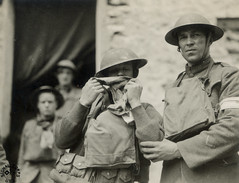 War and Medicine (22 November 2008-15 February 2009) is on display in London. I imagine this is a good exhibit. Be sure to check out the image galleries which in particular have a couple of nice shell shock images. You can see this one of ours on our flickr site as well as some mustard gas images. We recently put some facial reconstruction models on display very similar to the one seen in the photos on the Wellcome site, except ours are colored.
War and Medicine (22 November 2008-15 February 2009) is on display in London. I imagine this is a good exhibit. Be sure to check out the image galleries which in particular have a couple of nice shell shock images. You can see this one of ours on our flickr site as well as some mustard gas images. We recently put some facial reconstruction models on display very similar to the one seen in the photos on the Wellcome site, except ours are colored.
Monday, January 5, 2009
Jan 7: Museum exhibit manager Steve Hill speaking on Resolved exhibit design
This is one of AFIP's professional education lectures, but I imagine if one wanted to attend, one could.
The following lecture is presented by the National Museum of Health and Medicine
Date/Time: 07 Jan 09/1100am
Location: Dart Auditorium
Speaker(s): Steven Hill
Exhibits Manager
National Museum of Health and Medicine
Title:
“RESOLVED: Turning a good idea, clinical expertise, and field experience into a museum exhibit”
Objectives:
To explain how a scientific/health museum exhibit is created from the ground up
Description:
Talk will cover all aspects of turning an idea—in this case the United States’ commitment to individual identification of its war dead—into an museum exhibit. Subtopics will include differences between museum exhibit and other forms of communication/education, how concepts are refined and broken down into topics that can be visually presented in a museum setting, selection and security of artifacts, exhibit design and visitor flow, construction and installation.
The following lecture is presented by the National Museum of Health and Medicine
Date/Time: 07 Jan 09/1100am
Location: Dart Auditorium
Speaker(s): Steven Hill
Exhibits Manager
National Museum of Health and Medicine
Title:
“RESOLVED: Turning a good idea, clinical expertise, and field experience into a museum exhibit”
Objectives:
To explain how a scientific/health museum exhibit is created from the ground up
Description:
Talk will cover all aspects of turning an idea—in this case the United States’ commitment to individual identification of its war dead—into an museum exhibit. Subtopics will include differences between museum exhibit and other forms of communication/education, how concepts are refined and broken down into topics that can be visually presented in a museum setting, selection and security of artifacts, exhibit design and visitor flow, construction and installation.
Thursday, January 1, 2009
Whatever Happened to Polio? exhibit photos
When the Smithsonian's National Museum of American History closed in 2006, one of the things that went with it was Katherine Ott's excellent exhibit "Whatever Happened to Polio?" I don't know if the exhibit is in the re-opened museum, but when I ran across my pictures I figured I'd share them here.
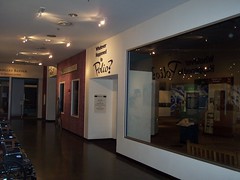

Would a vaccine work? panels
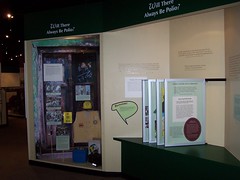
Will there always be polio? panels

What do these devices do? panel with crutches.

What is polio? panels
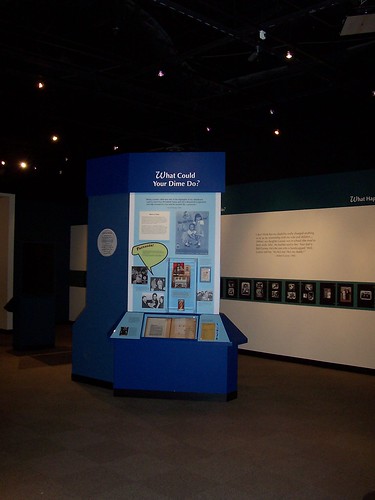
What could your dime do? (for the March of Dimes) panel
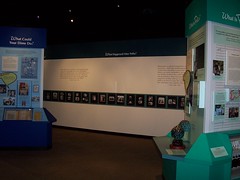

How did polio change us? panels
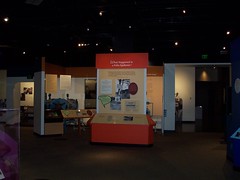
What happened in a polio epidemic? panel

Interactive station

Iron lung.
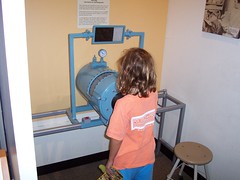
Model showing how iron lung reduced pressure to enable lungs to fill with air.
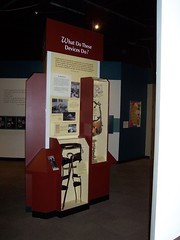
What do these devices do? panel with braces.
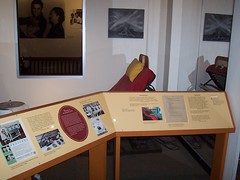



Would a vaccine work? panels

Will there always be polio? panels

What do these devices do? panel with crutches.

What is polio? panels

What could your dime do? (for the March of Dimes) panel


How did polio change us? panels

What happened in a polio epidemic? panel

Interactive station

Iron lung.

Model showing how iron lung reduced pressure to enable lungs to fill with air.

What do these devices do? panel with braces.


Wednesday, December 3, 2008
New exhibit
The Historical Collections guys and the exhibit guy finished putting together an exhibit yesterday and I went over and shot some of the process as well as the finished product. Because I know for a fact, yes a fact, that not one of them will write about it, I'm doing it because I'm so responsible. And because I love behind-the-scenes stuff and assume you do too.
The exhibit is contained in one wall-mounted cabinet and is called Facial Reconstruction. We have really cool and interesting plaster models and they're what make up the bulk of the cabinet. Here are four on them on a cart, waiting to go into the cabinet. They're various stages of one person's reconstruction.

Here are two of the three guys working on the cabinet.

They used the line of the bottom row of models (the ones shown on a cart above) to mark a line for the next row up. Here's that bottom row being hung.

Here's the exhibits guy using a spiffy, bendy thing on the drill to make a hole for the next row up.

A test fit on the second row.

Here's a close-up of them on a cart.

The models are all safely tucked away again and the labels are installed.

Here are a couple different models, both from World War 1. The first one shows a nasal splint after the surgeon rebuilt his nose from a flap of skin from his forehead. Note the scar.

This one shows an appliance used to keep his fractured upper jaw aligned correctly within his face.

This is a more contemporary model. This man sustained a severe head injury and a portion of his skull was removed to allow his swollen brain to expand. A CT scan of his head allowed the doctors to create a resin model of his skull and then make a cranial plate based on a mirror image of the undamaged side of his skull. This view shows a portion of the skull removed. It's art, isn't it?

And finally, the finished exhibit. Ta-Da!!

The exhibit is contained in one wall-mounted cabinet and is called Facial Reconstruction. We have really cool and interesting plaster models and they're what make up the bulk of the cabinet. Here are four on them on a cart, waiting to go into the cabinet. They're various stages of one person's reconstruction.

Here are two of the three guys working on the cabinet.

They used the line of the bottom row of models (the ones shown on a cart above) to mark a line for the next row up. Here's that bottom row being hung.

Here's the exhibits guy using a spiffy, bendy thing on the drill to make a hole for the next row up.

A test fit on the second row.

Here's a close-up of them on a cart.

The models are all safely tucked away again and the labels are installed.

Here are a couple different models, both from World War 1. The first one shows a nasal splint after the surgeon rebuilt his nose from a flap of skin from his forehead. Note the scar.

This one shows an appliance used to keep his fractured upper jaw aligned correctly within his face.

This is a more contemporary model. This man sustained a severe head injury and a portion of his skull was removed to allow his swollen brain to expand. A CT scan of his head allowed the doctors to create a resin model of his skull and then make a cranial plate based on a mirror image of the undamaged side of his skull. This view shows a portion of the skull removed. It's art, isn't it?

And finally, the finished exhibit. Ta-Da!!

Labels:
exhibits,
facial reconstruction,
facial wounds,
Historical Collections,
plaster models,
plastic surgery,
resin models
Thursday, September 18, 2008
Exhibit Design for MHS


A day in the life of, exhibits...
Exhibit Design for Military Health System
I had the privilege of art directing and designing
this for MHS.
Yea, I worked this up using
Photoshop, Indesign, & Cinema-4D. The artwork
was inspired by and uses photos from the respective
websites, but the mural is just a comp. I just love engineering
structure. This one was tough as hell though. Comments please.
credit of photos
Department of the Army,
Department of the Navy,
US Coast Guard,
US Air Force
MHS
and of course several images from the National Museum of Health & Medicine archives.
Art Director - Navjeet Singh Chhina
Design- Navjeet Singh Chhina
Tuesday, September 16, 2008
Poster exhibit talk at National Academy of Sciences
Thursday, September 4, 2008
RESOLVED exhibit spotlighted today
More links for you this evening, this time featuring our newest exhibit RESOLVED: Advances in Forensic Identification of U.S. War Dead.
- At the Danger Room blog, brought to you by the people at Wired magazine, they were nice enough to link to the exhibition's Web site
- Medical News Today published the news release today, too.
Enjoy!
Wednesday, August 20, 2008
Save the Date: Stigma of Leprosy Discussion, Wed., 8/27, 2pm in the Museum
Save the Date: Stigma of Leprosy Discussion, Wed., 8/27, 2pm in the Museum
Afternoon Coffee Talk at the National Museum of Health and Medicine
"Carville: The Landscape of Stigma" with guest speaker Elizabeth Schexnyder, Curator, The National Hansen's Disease Museum.
Join a discussion on how the fear of leprosy led to displays of stigma associated with the disease. Learn how "othering" human beings diagnosed with leprosy shaped the unique social and physical landscape of the National Leprosarium at Carville, Louisiana. After the talk, visit the temporary exhibition 'Triumph at Carville: A Tale of Leprosy in America.'
When: Wednesday, August 27, 2:00-3:00 p.m.
Where: Russell Auditorium (in the Museum, Bldg. 54)
Cost: FREE!! Coffee!!
Afternoon Coffee Talk at the National Museum of Health and Medicine
"Carville: The Landscape of Stigma" with guest speaker Elizabeth Schexnyder, Curator, The National Hansen's Disease Museum.
Join a discussion on how the fear of leprosy led to displays of stigma associated with the disease. Learn how "othering" human beings diagnosed with leprosy shaped the unique social and physical landscape of the National Leprosarium at Carville, Louisiana. After the talk, visit the temporary exhibition 'Triumph at Carville: A Tale of Leprosy in America.'
When: Wednesday, August 27, 2:00-3:00 p.m.
Where: Russell Auditorium (in the Museum, Bldg. 54)
Cost: FREE!! Coffee!!
Saturday, August 9, 2008
Another view of our Resolved exhibit

I think this is my favorite view of the exhibit. That's a transfer case draped with a flag and a backdrop from the Joint POW/MIA Accounting Command Forensic Anthropology Lab at Hickam AFB in Hawaii, showing the process of reconstructing human skeletons with the aim of identification. I always assumed it was a casket that brought our soldiers home, but it's not. The same grim purpose, a more utilitarian box.
Wednesday, August 6, 2008
Is there any place for human remains in a museum (these days)?



Mike's post yesterday about a conference at which the title of this post will be discussed leads me to show you these pictures. They're all from our Resolved exhibit on identifying human remains. I'll show more pictures of the exhibit in future posts, but try to imagine the gaps if these body parts, out of squeamishness or political correctness, were no longer in our collection. Imagine our anatomical collections manager trying to explain, in words alone, how a female and male pelvis are different. Or what the mandible of a child of a particular age looks like (remember, no objects for illustration). Or the differences among the skulls of Europeans, Asians, and Africans. I'm still kind of new to the museum game as an employee, but as a long-time museum-goer, I think there's not a lot of place for this kind of question from museum professionals.
Subscribe to:
Posts (Atom)